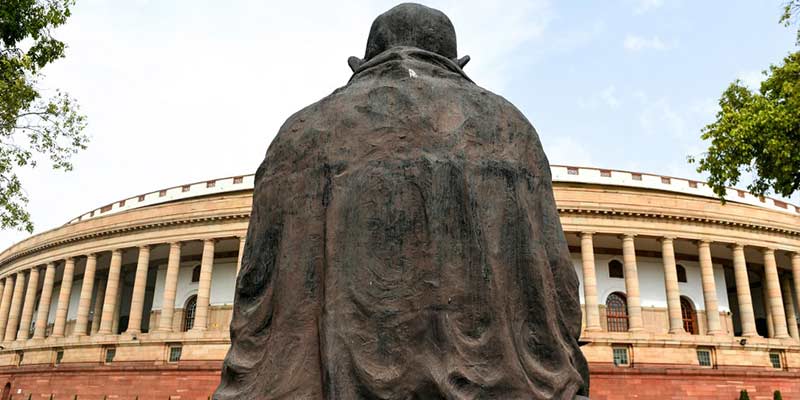- India
- Nov 19
Explainer / Rajya Sabha’s milestone day
Addressing the 250th session of the Rajya Sabha, Prime Minister Narendra Modi said that the Upper House of Parliament is the soul of India’s federal structure. He said the Rajya Sabha has made significant contributions to India’s history and also seen history being made. He said the vision of the makers of the Constitution in creating a bicameral legislative framework has enriched our democracy.
He said the Rajya Sabha never dissolves and its continuance in perpetuity makes the House eternal. It provides an opportunity to those away from electoral politics to contribute to the nation and its development, he added.
Background
The Council of States, also known as the Rajya Sabha, a nomenclature that was announced by the chair in the House on August 23, 1954, has its own distinctive features. Its origins can be traced to the Montague-Chelmsford Report of 1918.
The Government of India Act, 1919, provided for the creation of a Council of States as a second chamber of the then legislature with a restricted franchise, which actually came into existence in 1921. The governor-general was the ex-officio president of the Council of States. The Government of India Act, 1935, hardly made any changes in its composition.
The Constituent Assembly, which first met on December 9, 1946, also acted as the Central Legislature until 1950, when it was converted into the Provisional Parliament. During this period, the Central Legislature which was known as Constituent Assembly (Legislative) and later Provisional Parliament was unicameral till the first polls were held in 1952.
Extensive debate took place in the Constituent Assembly regarding the utility or otherwise of a second chamber in independent India and ultimately, it was decided to have a bicameral legislature for independent India mainly because a federal system was considered to be the most feasible form of government for such a vast country with immense diversities.
A single directly elected House, in fact, was considered inadequate to meet the challenges faced by independent India. Therefore, a second chamber known as the Council of States was created with an altogether different composition and method of election from that of the directly elected House of the People.
It was conceived as another chamber, with smaller membership than the Lok Sabha. It was meant to be the federal chamber i.e., a House elected by the elected members of Assemblies of states and Union Territories in which states were not given equal representation.
Apart from the elected members, a provision was also made for the nomination of 12 members to the House by the president. The minimum age of 30 years was fixed for membership as against 25 years for the Lok Sabha. The element of dignity and prestige was added to the Council of States by making the vice-president ex-officio chairman of the Rajya Sabha who presides over its sittings.
Qualifications
Article 84 of the Constitution lays down the qualifications for membership of Parliament. A person who wants to be a Rajya Sabha member should possess the following qualifications…
* He must be a citizen of India and make and subscribe before some person authorised in that behalf by the Election Commission an oath or affirmation according to the form set out for the purpose in the Third Schedule to the Constitution.
* He must be not less than 30 years of age.
* He must possess such other qualifications as may be prescribed in that behalf by or under any law made by Parliament.
Special powers
Being a federal chamber, the Rajya Sabha enjoys certain special powers under the Constitution. All the subjects / areas regarding legislation have been divided into three lists - Union List, State List and Concurrent List. The Union and State Lists are mutually exclusive - one cannot legislate on a matter placed in the sphere of the other. However, if the Rajya Sabha passes a resolution by a majority of not less than two-thirds of members present and voting saying that it is “necessary or expedient in the national interest” that Parliament should make a law on a matter enumerated in the State List, Parliament becomes empowered to make a law on the subject specified in the resolution, for the whole or any part of the territory of India. Such a resolution remains in force for a maximum period of one year, but this period can be extended by one year at a time by passing a similar resolution further.
If the Rajya Sabha passes a resolution by a majority of not less than two-thirds of the members present and voting declaring that it is necessary or expedient in the national interest to create one or more All India Services common to the Union and the states, Parliament becomes empowered to create by law such services.
Under the Constitution, the president is empowered to issue proclamations in the event of a national emergency, in the event of failure of constitutional machinery in a state, or in the case of financial emergency. Every such proclamation has to be approved by both Houses of Parliament within a stipulated period. Under certain circumstances, however, the Rajya Sabha enjoys special powers in this regard. If a proclamation is issued at a time when the Lok Sabha has been dissolved or the dissolution of the Lok Sabha takes place within the period allowed for its approval, then the proclamation remains effective, if the resolution approving it is passed by the Rajya Sabha within the period specified in the Constitution under Articles 352, 356 and 360.
Manorama Yearbook app is now available on Google Play Store and iOS App Store

